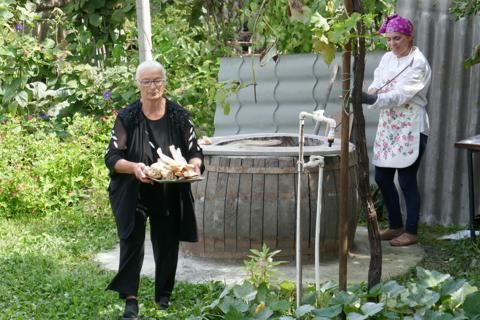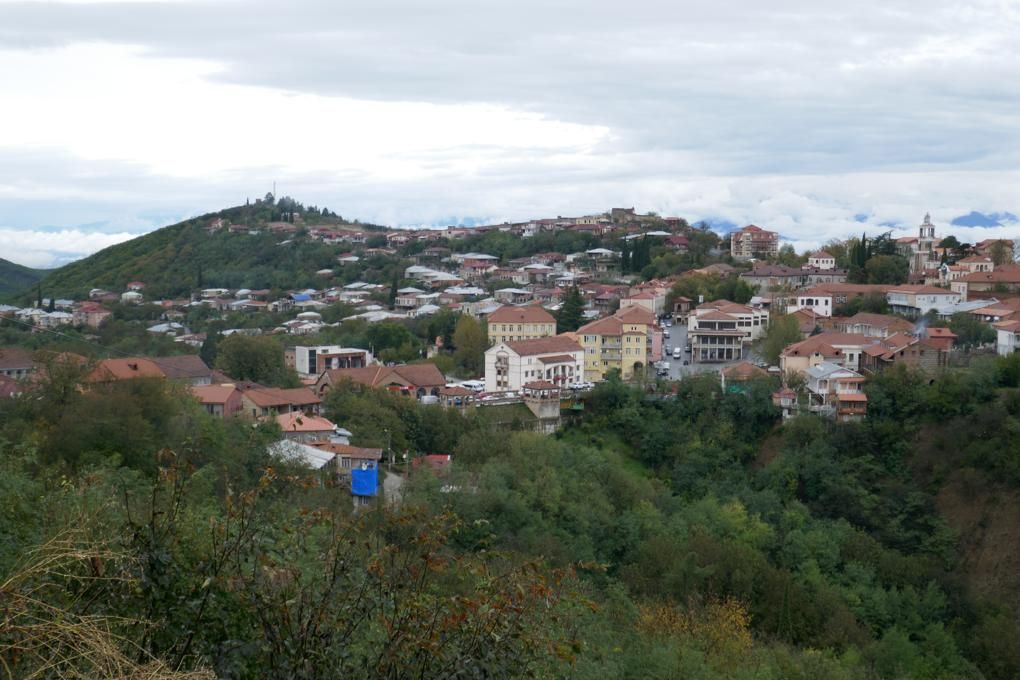The Caucasus - Georgia - Part 1

After crossing the border into Georgia, we met our new guide Sali, a vibrant young lady, proud of her country, offering us just the right amount of detail.
We drove through rolling hills of the Kakheti region, covered with grape vines and soon gathered on the veranda of a local family’s farmhouse, shaded by grapevines, indulging in fresh produce for lunch and of course a glass of wine or two…
Bread freshly baked in the family’s wood fired oven - the dough rolled in long strips and slapped to the inside of the hot oven walls - it’s quite a skill to heat the oven to the correct temperature and to know when the bread is cooked to perfection. Enough bread is made for a week - shared between themselves and neighbouring families.






Clay pots with grape seeds have been found at archaeological digs, dating back 8,000 years - Georgia wins the prize as the birth place of wine. Today 500 endemic vine breeds are still nurtured. As we soon find out, there’s a lot to love about this country.
Wine is made in a very different way here - after crushing the juice, it’s fermented for 4-6 weeks in Qvevri - giant clay pots of varying sizes, buried in the ground, with only the vessel’s rim visible. Many of the qvevri found in Georgia today have been in use for decades, if not centuries.
The qvevri are then sealed with wax and allowed to mature for a further 4-6 months, when it’s ready to drink.



In between trying wines and local foods we were whisked away to visit a few churches. Georgian religious architecture has a unique style characterised by tall domes and a stone roof.
In the ancient town of Gremi which was briefly the capital of the Kakheti region - we visited the Church of the Archangels, as you can see below, perched atop a hill, considered a masterpiece of Georgian late medieval architecture built between 1565-1577. A small museum in the Bell Tower showed the simple lifestyle of royals at the time (bottom right photo) and I quite liked the royal toilet with a view, tucked away in a corner! (bottom middle photo).

Georgians live simply with homes close together in villages; family and grapes more important than beautiful houses - with so much conflict over the years and centuries, they are ready to flee at a moment’s notice leaving everything behind - even today! Often city dwellers return to the family property to assist with the harvest.
Georgia has a coastline along the Black Sea - a strategically important link from Asia to Europe and it was part of the Great Silk Road! Its a predominately Christian country - in fact it was one of the first countries to adopt Christianity as its state religion - in 337CE, second only to Armenia in 301CE. Now mosques and mausoleums are replaced with churches - often beautifully decorated with frescos.
Under rainy skies we explored Alaverdi - a centre for famous Georgian writers, calligraphers, and bibliophiles. The complex includes a working monastery and the St George Cathedral - one of the largest church buildings in Georgia - 40 metres tall, including the dome.
In Georgia women must wear head scarves in church and here even slacks were not enough - both men and women, needed to borrow wraparound skirts. Inside, the church was magical, with such a feeling of peace, (sadly no photos allowed) oil lamps dotted on every wall, illuminating frescos dating back to 11th century, some of which were not completed until the 15th-17th centuries.

We moved forward a few hundred years to 19th century and Tsinandali Estate learning the history of Prince Alexander Chavchavadze, founder of the Romanticism movement in Georgia.
Our guide related the story that it was in this beautifully landscaped European garden that Alexander fell madly in love with his future wife Salome. Today the legend says that if lovers walk through the love lane with their eyes closed, their life together will be happy.
We are never far from wine though - Tsinandali produced the first bottled wine in Georgia and Prince Alexander's collection of vintage wines consisted of over 15,000 bottles, the oldest dated, 1814.
It seems we aren’t far away from love either as we stopped at the town of Sighnaghi, known as the City of Love - couples can get married any time of the day here. It’s picturesque, perched on a hilltop facing the snowcapped Caucasus Mountains overlooking the vast Alazani Valley, not too far from the capital, Tbilisi, either, when couples are looking for a weekend escape.

The cobbled streets lined with balconied buildings and wine bars - yes another wine tasting. This time at Pheasant’s Tears founded in 2007 by American painter John Wurdeman and Gela Patalishvili, whose family’s connection with wine, using the qvevri method goes back eight generations. John fell in love with Georgia and now lives in Sighnaghi. The name Pheasant’s Tears refers to a Georgian story - when the very best wines are good enough to make a pheasant cry. To my mind a crying shame to share good wine with pheasants!





Tomorrow we explore some important religious sites of Georgia.
